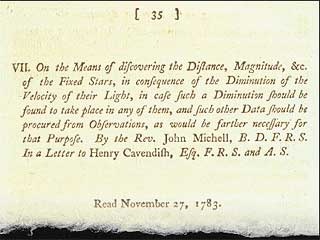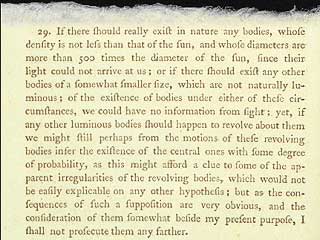The Country Parson Who Conceived of Black Holes
Part of the Cosmic Horizons Curriculum Collection.

This astonishing idea was first announced in 1783 by John Michell, an English country parson. Although he was one of the most brilliant and original scientists of his time, Michell remains virtually unknown today, in part because he did little to develop and promote his own path-breaking ideas.
Michell was born in 1724 and studied at Cambridge University, where he later taught Hebrew, Greek, mathematics, and geology. No portrait of Michell exists, but he was described as “a little short man, of black complexion, and fat.” He became rector of Thornhill, near Leeds, where he did most of his important work. Michell had numerous scientific visitors at Leeds, including Benjamin Franklin, the chemist Joseph Priestley (who discovered oxygen), and the physicist Henry Cavendish (who discovered hydrogen).
The range of his scientific achievements is impressive. In 1750, Michell showed that the magnetic force exerted by each pole of a magnet decreases with the square of the distance. After the catastrophic Lisbon earthquake of 1755, he wrote a book that helped establish seismology as a science. Michell suggested that earthquakes spread out as waves through the solid Earth and are related to the offsets in geological strata now called faults. This work earned him election in 1760 to the Royal Society, an organization of leading scientists.
Michell conceived the experiment and built the apparatus to measure the force of gravity between two objects of known mass. Cavendish, who actually carried out the experiment after Michell’s death, gave him full credit for the idea. The measurement yeilded a fundamental physical quantity called the gravitational constant, which calibrates the absolute strength of the force of gravity everywhere in the universe. Using the measured value of the constant, Cavendish was able for the first time to calculate the mass and the average density of the Earth.

Michell was also the first to apply the new mathematics of statistics to astronomy. By studying how the stars are distributed on the sky, he showed that many more stars appear as pairs or groups than could be accounted for by random alignments. He argued that these were real systems of double or multiple stars bound together by their mutual gravity. This was the first evidence for the existence of physical associations of stars.
But perhaps Michell’s most far-sighted accomplishment was to imagine the existence of black holes. The idea came to him in 1783 while considering a hypothetical method to determine the mass of a star. Michell accepted Newton’s theory that light consists of small material particles. He reasoned that such particles, emerging from the surface of a star, would have their speed reduced by the star’s gravitational pull, just like projectiles fired upward from the Earth. By measuring the reduction in the speed of the light from a given star, he thought it might be possible to calculate the star’s mass.
Michell asked himself how large this effect could be. He knew that any projectile must move faster than a certain critical speed to escape from a star’s gravitational embrace. This “escape velocity“ depends only on the size and mass of the star. What would happen if a star’s gravity were so strong that its escape velocity exceeded the speed of light? Michell realized that the light would have to fall back to the surface. He knew the approximate speed of light, which Ole Roemer had found in the previous century. So it was easy for Michell to calculate that the escape velocity would exceed the speed of light on a star more than 500 times the size of the Sun, assuming the same average density. Light cannot escape from such a body, which would, therefore, be invisible to the outside world. Today we would call it a black hole.
Michell got the right answer, although he was wrong about one point. We now know, from Einstein’s relativity theory of 1905, that light moves through space at a constant speed, regardless of the local strength of gravity. So Michell’s proposal to find the mass of a star by measuring the speed of its light would not have worked. But he was correct in pointing out that any object must be invisible if its escape velocity exceeds the speed of light. This concept was so far ahead of its time that it made little impression.
The idea of black holes was rediscovered in 1916, after Einstein published his theory of gravity. Karl Schwarzschild then solved Einstein’s equations for the case of a black hole, which he envisioned as a spherical volume of warped space surrounding a concentrated mass and completely invisible to the outside world. Work by Robert Oppenheimer and others then led to the idea that such an object might be formed by the collapse of a massive star. The term “black hole“ was itself coined in 1968 by the Princeton physicist John Wheeler, who worked out further details of a black hole’s properties.
The most common black holes are probably formed by the collapse of massive stars. Larger black holes are thought to be formed by the sudden collapse or gradual accretion of the mass of millions or billions of stars. Most galaxies, including our own Milky Way, probably contain such supermassive black holes at their centers.
Astrophysical theory allows black holes to come in many sizes, and the size of a black hole is simply proportional to its mass. Thus, a black hole with the mass of the Earth would be about an inch across, one with the mass of the Sun would be a few miles across, and one with the total mass of the Milky Way Galaxy would be about a light-year across. The larger a black hole, the lower its average density, and it is conceivable that our entire observable universe is a supermassive black hole within a larger universe.
Michell suggested that we might detect invisible black holes if some of them had luminous stars revolving around them. In fact, this is one method used by astronomers today to infer the existence of black holes. We have observed numerous systems in which matter, whether gas clouds or entire stars, is moving so fast that only the concentrated mass of a black hole could be responsible for it.
While black holes strongly influence the space immediately around them, the notion that they behave like cosmic vacuum cleaners, sweeping up everything in the neighborhood, is a popular fallacy. If the Sun were somehow collapsed to form a black hole, the orbital motion of the planets would be unaffected. The central mass would remain the same, so the planets would feel the same gravity as before. What distinguishes a stellar black hole is its very small size and high density. This allows other bodies to get very close to the center of mass, where the gravity is extremely intense. But it does not increase the pull of gravity far away from the mass.
When John Michell conceived of black holes in 1783, very few scientists in the world were mentally equipped to understand what he was talking about. It is not surprising that the concept sank into complete obscurity and had to be rediscovered in the twentieth century.
This is an excerpt from COSMIC HORIZONS: ASTRONOMY AT THE CUTTING EDGE, edited by Steven Soter and Neil deGrasse Tyson, a publication of the New Press. © 2000 American Museum of Natural History.